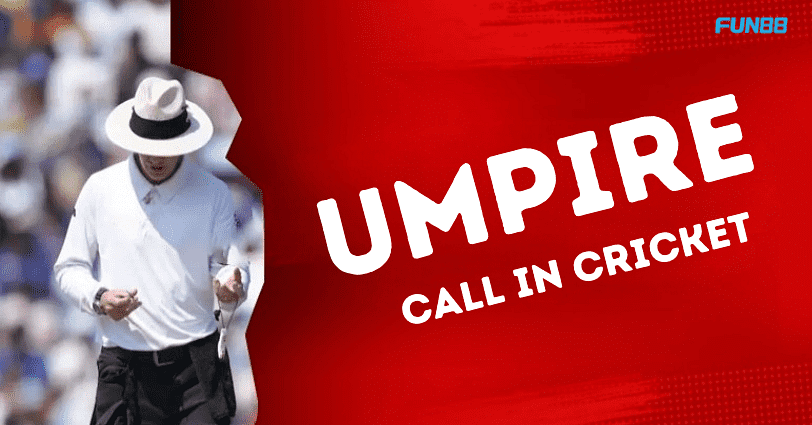Although cricket is fun, it can be a bit complex sometimes. Today, the game deploys several technologies and technicalities, which may confuse casual viewers. Umpire calls in cricket may confuse viewers and may draw polarising reactions. Such calls come into the gameplay when the third umpire cannot convincingly decide on one of the three factors of a Leg-before-wicket decision: ball pitch, impact, or whether a ball has hit a wicket. In such scenarios, the third umpire agrees to the on-field umpire’s decision, known as the umpire’s call.
If that sounds confusing, do not worry. In this guide on umpire’s call, you will learn a lot about the essentialities of it in cricket. So, delve deeper into the cricket world and explore the significance and impact of the umpire’s calls.
Umpire Calls in Cricket: Explore the Meaning
On 1 October 2016, the umpire’s call rule was implemented, in which the DRS backs the original decision made by the on-field umpire. When a batter is declared out LBW and the initial decision is reviewed, the third umpire should uphold the decision that the on-field umpire has made if the replays show that approximately half part of the ball hits an area, which includes the off and leg stumps’ outer edges.
For instance, when a team challenges the original decision made by an on-field umpire, the ball-tracking technology depicts that the ball’s path hardly touches the stumps but falls within an uncertain margin; in this scenario, the initial decision of the on-field umpire is retained.
Controversy Surrounding the Umpire’s Call in Cricket
The umpire call has bewildered many in cricket because of its perplexing technicalities. A few cricket players even wanted it to be banned. Legendary cricket players like Sachin Tendulkar, Ricky Pointing, and Shane Warne have voiced their opinions on eradicating the umpire call from the Decision Review System. The primary problem with the umpire’s call is that the cricket players and spectators find it highly confusing. It turns simple decisions into major complications and often results in inaccurate resolutions.
Let’s understand this using an example. Suppose less than 50% of the ball hits the stumps. According to Hawk-Eye path estimates, it will be regarded as the balls missing the wickets. But bowlers and wicketkeepers argue that the ball’s surface that hits the stumps or bails in cricket is sufficient for the batters’ wicket. The 50% rule is also applicable in the case of pitching and impact points.
Even though the International Cricket Council has slightly changed the Decision Review System rules, the umpire call rules still disappoint players. Previously, it has led to many controversial dismissals in matches.
Controversies and outrage occur when the umpire’s calls in cricket are against the most-favoured teams or players or when the estimated pathway does not match the expectations or predictions of cricket fans.
Also Read: What is Dot Ball in Cricket?
Merits of the Umpire’s Call
The Umpire’s calls are an important factor in the DRS, primarily used in cricket matches for LBW decisions.
The Following Are the Merits of the Umpire’s Call for the Batting and Bowling Teams
- Retaining Reviews
The bowling team can retain the review whenever the ball-tracking technology proves the decision is within the on-field umpire’s call margin. It can be beneficial if players think a review is required for a more vital decision later in the innings.
- Psychological Impact
Even if the final decision aligns with that of the on-field umpire in favour of the bowling team, the decision’s close nature can sow seeds of doubts and uncertainties in the batter’s mind. This psychological effect might work for the bowling team.
- A Lifeline for batters
The umpire’s call in cricket often works like a lifeline for batters in close leg-before-wicket decisions where the ball partly hits the stumps but lies within a fair error margin. It can prove vital for batters batting in the top order or for important players in the batting lineup.
Also Read: Mankading in Cricket – Most Sensational & Controversial Rule
Demerits of the Umpire’s Call
The following are some of the demerits of the umpire’s call concerning the batting and bowling teams:
- Frustrating for the Bowling Team
Suppose the umpire’s call stands against the bowling team. In that case, they lose the opportunity to change the decision despite the ball meeting the stumps. It can be frustrating for the bowling team if they specifically think that the batter must be declared out.
- Uncertain Nature
An uncertain element remains in the batter’s mind even if they are saved from an instant dismissal. Especially if the ball tracking technology depicts that the ball had hit the stumps but only due to the margin of the umpire’s calls the batter was saved. Thus, it affects the batter’s confidence, self-esteem, and concentration.
- Fewer Reviews
Suppose the umpire calls to stand against the batting team. In that case, they lose a review. Losing reviews can hold significance in tricky matches where a team may have to challenge a vital decision later in the game.
Thus, the umpire call system has pros and cons both for the batting and bowling teams. Its goal is to maintain a balance between the on-field umpire’s decision and the use of technology in reviewing decisions, leading to more accurate decisions.
Also Read: 10 Things To Know About Online Cricket Betting In India
Popular Controversies Around the Umpire’s Call
Even though the umpire calls are important in cricket, their implementation has stirred controversies since its integration into the gameplay. The following are some popular instances related to the controversies surrounding an umpire’s call in cricket:
- Ben Stokes’ Leg Before Wicket Decision in Ashes 2019
- Dismissal of Cheteshwar Pujara in India vs Australia in the 2020-21 Series
- Dismissal of Joe Root in India vs England in 2021
- Dismissal of Faf Du Plessis in South Africa vs England in 2020
The above instances showcase that the umpire’s call rule has concerned players, veterans, spectators, and experts. The controversies often revolve around the error margin of the technology and its effect on the match’s outcome.
Conclusion
The umpire’s calls in cricket are like a double-edged sword. The Decision Review System was introduced to fix errors if umpires made a mistake. The same adjourns to the on-field umpires in case of doubts. It might sound a little weird, but that is how the cricket rules have always been. Players must learn to use the Decision Review System judiciously. Understanding the umpire call is necessary for grasping the essentialities of making decisions in cricket.
Star it if you find it helpful.

